Seasons – September 2021
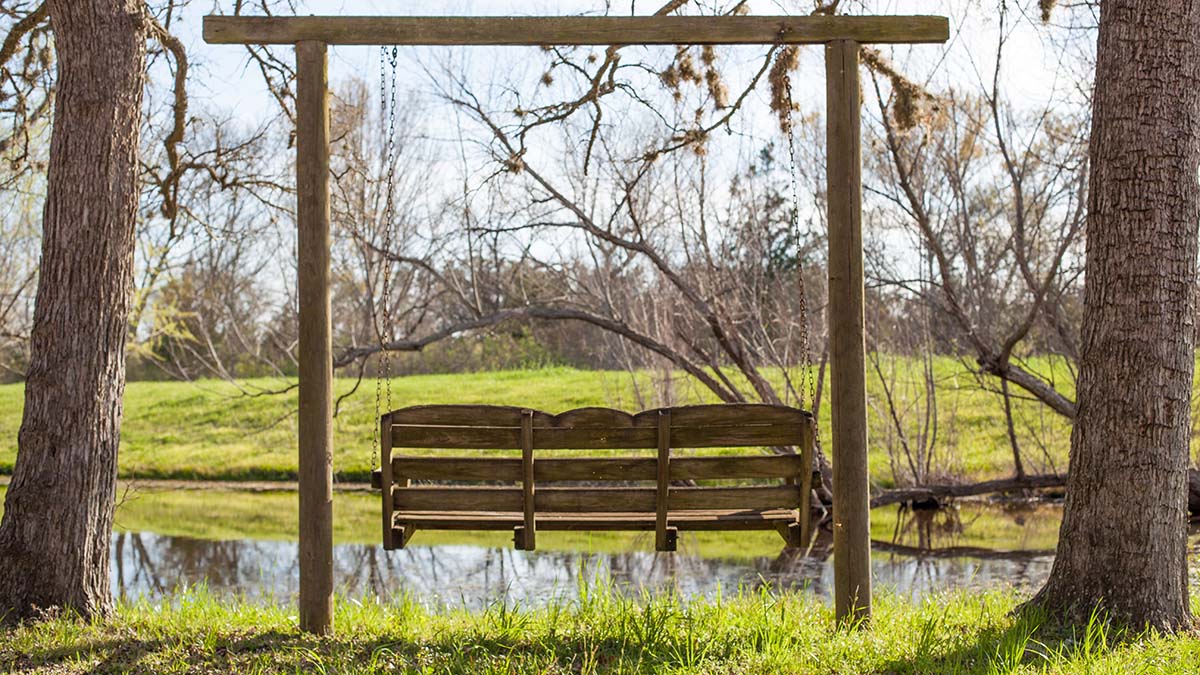
From the Plateau Land & Wildlife Management Team
With kiddos heading back to school, it may seem that outdoor time with family can be limited. However, there are tons of activities that parents, teachers, and family members can participate in to engage their children in outdoor fun and learning time. Plus, with cooling temperatures right around the corner, fall offers everyone a reprieve from the Texas heat and bugs.
In this issue of Seasons we offer fun and timely outdoor activities for your family this fall, including fall birds you can look for in your very backyard, and a wildlife identification tool the whole family will benefit from. As always, we hope you enjoy all that this season and Seasons has to offer!
Until next Seasons,
The Plateau Team
Table of Contents
Fun, Fall Activities for Families
Wildlife Management Activity Reminder: Supplemental Food
5 Tips to Attract Backyard Birds
Service Spotlight: Fall Webinars
iNaturalist Review: What is it, and how do I use it?
Field Notes: Pictures & Highlights of Properties in Wildlife Management
News for Texas Landowners
Fun, Fall Activities for Families
By Nick Fisher, Plateau Region Manager of Central Texas
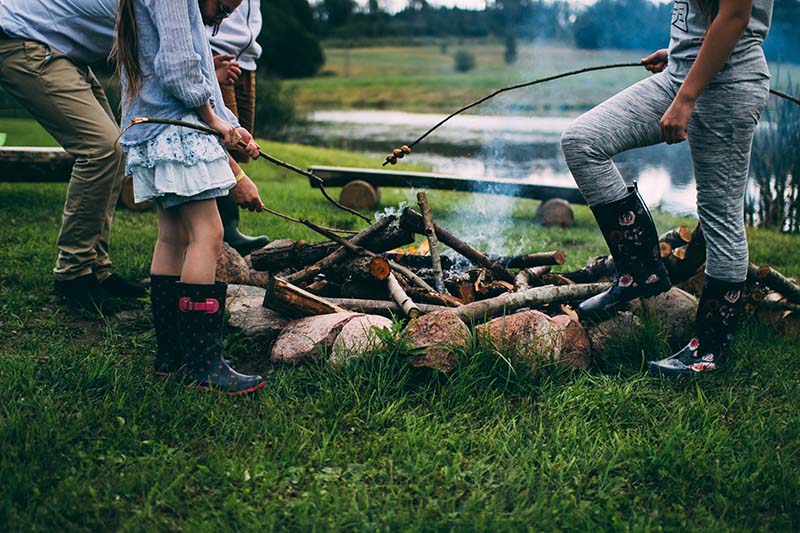 Contrary to popular belief, Texas will drop below 90 degrees at some point in the year. It’s a short-lived treat that families and wildlife alike probably take for granted. But when it does, the cool breeze is a much-appreciated change from the summer winds that seem to originate in a furnace. This time of the year draws the bucks into rut, the doves to the sunflower fields, and the families outdoors—and you don’t even have to be sitting in a tube floating down a river to stay cool.
Contrary to popular belief, Texas will drop below 90 degrees at some point in the year. It’s a short-lived treat that families and wildlife alike probably take for granted. But when it does, the cool breeze is a much-appreciated change from the summer winds that seem to originate in a furnace. This time of the year draws the bucks into rut, the doves to the sunflower fields, and the families outdoors—and you don’t even have to be sitting in a tube floating down a river to stay cool.
As kids, most of us grew up outside flipping rocks, or fishing, or just exploring the woods somewhere. The youth’s appreciation for the natural world has since been slightly blurred by screen time and other indoor activities. With the aroma of sunscreen and the 14-hour days becoming a memory of the summer months, now is a great opportunity to get involved with your family and get them outside. Recall the times that you drowned worms in an attempt to hook onto a largemouth bass that you would later tell stories about; brag of the enormity of the trees that you once climbed without effort; and speak of the beauty of nature to your young ones whether it be the Hill Country, the Piney Woods, or the open prairies with Big bluestem 5-feet high scattered across the landscape. In Central Texas, it’s not difficult to get back to nature with state parks and natural areas scattered throughout the Edwards Plateau ecoregion.
One of the most rewarding things in life is witnessing a young child put together how nature works. The questions they ask, and the creative thoughts that fill their heads, can instantly bring a smile to your face and are likely questions that you have never thought of. The importance of allowing younger generations to explore the outdoors and appreciate the natural world goes far beyond establishing creative thinking. It also provides many physical and mental health benefits.
My favorite pastime is being outside with my two young kids. I have a 3-year-old girl and a 5-year-old boy that I take with me everywhere I go. They bring John Muir’s quote to light each time we get outdoors: “In every walk with nature, one receives far more than he seeks.” As an avid outdoorsman and a family-oriented father, I love sharing my experiences with others, no matter how small and seemingly insignificant at the time. Sharing the fun and the fallouts helps others realize they don’t have to do it perfectly to reap the benefits.
Activity Suggestions for Your & Your Family
The most obvious activity that can really get kids to appreciate the outdoors is camping. Something about sleeping under the stars and the sounds of crickets in the trees tend to humble oneself. You don’t have to be an expert to make it happen, and trying to get everything REI has to offer can be overwhelming if you let it. Keep it simple—bring fire starters and some hot dogs, and let the natural world clear your mind from the chaos. Although not many want to face sleeping in a un-airconditioned tent during a Texas summer, state parks in Texas fill up quickly when you can wake up and jump into the Frio, the Blanco, the Pedernales, the Guadalupe, or the Llano River…not to mention fishing and well-maintained trails draw in crowds all year long. Although worth it, one does not necessarily need to make the trek out to Big Bend National Park or Caprock Canyons State Park to enjoy sleeping under the stars or a dark night sky. Wimberley Valley and Dripping Springs are both recognized as an International Dark Sky Community, and a tent set up in the backyard is a safe and fun way to mimic the camping experience.
Here are a few camping essentials you won’t want to forget: bug spray, snacks, sunscreen, and plenty of water.
Fishing is another obvious activity that connects us with nature at any age. When that bobber disappears below the surface and the fight between man and fish is underway, there’s instant gratification for your accomplishment—whether the fish makes it to the shore or not. I know some adults whose enthusiasm for hooking onto a fish has been the same since they were a child. Kids are fascinated with scales, fish’s ability to breathe underwater, and fins in place of arms and legs. Again, you could easily get disoriented and spend thousands of dollars in a Bass Pro Shop, but I have never been one to spend too much on fishing gear. I often lose and find lost lures and other tackle along the banks and in the trees near the water. You may also find it enjoyable to catch your own bait, as I do, and save some money that way. When my 3-year-old daughter landed a 14-inch bass with her Disney Frozen fishing pole out of a pond at Palmetto State Park, it only warranted my decision to not go after the “biggest and baddest” of fishing gear. Now, fishing and catching are two different things, but as Henry David Thoreau once said, “Many men go fishing all of their lives without knowing that it is not fish they are after.”
Fishing essentials to consider: a body of water (preferably with fish), snacks, plenty of drinking water.
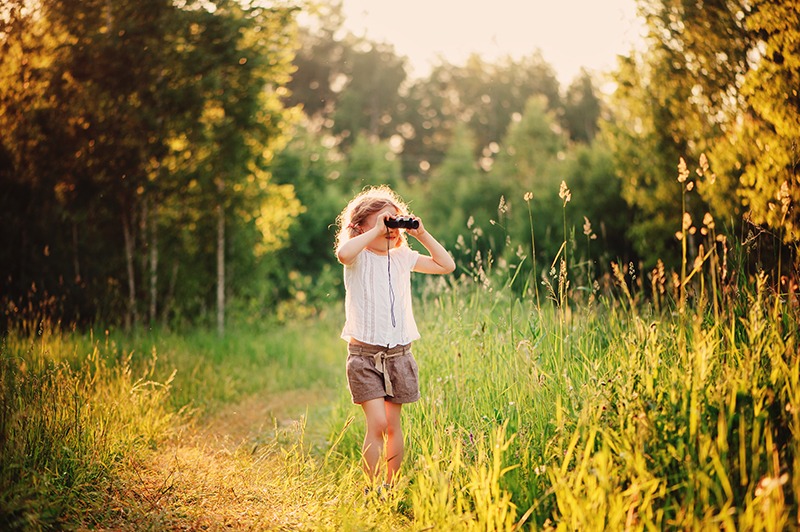 A less obvious and broader activity for families to enjoy together is the act of simply discovering and identifying. For example, when my kids were very young they used to collect fallen leaves and make leaf prints by putting them behind a piece of paper and coloring the page. Another easy and fun activity my daughter would do, is (sneakily) pick a variety of flowers on our walks and when we got home, we’d lay them out and figure out what each type was before giving them to mom. As the kids got quicker and more coordinated in life, so did the wildlife they collected. Flipping rocks and logs (with supervision) became our new way of finding wild things like roly-polies and beetles, and they have since developed a fascination with lizards and snakes. Obviously being with them along the way ensures you can remove them from anything less than a “safe find”, but it also allows you to learn about the organisms being found right along with them.
A less obvious and broader activity for families to enjoy together is the act of simply discovering and identifying. For example, when my kids were very young they used to collect fallen leaves and make leaf prints by putting them behind a piece of paper and coloring the page. Another easy and fun activity my daughter would do, is (sneakily) pick a variety of flowers on our walks and when we got home, we’d lay them out and figure out what each type was before giving them to mom. As the kids got quicker and more coordinated in life, so did the wildlife they collected. Flipping rocks and logs (with supervision) became our new way of finding wild things like roly-polies and beetles, and they have since developed a fascination with lizards and snakes. Obviously being with them along the way ensures you can remove them from anything less than a “safe find”, but it also allows you to learn about the organisms being found right along with them.
A more advanced version of wildlife identification that I am slowly introducing to the kids is birding. There are so many similar birds out there that getting started can be intimidating, but introductory birding can be done with no equipment at all. As you learn and develop as a birder, you may want to invest more into it, but to start just remember to keep your eyes peeled and listen to the specific calls and songs which will help you to identify bird species as you go. With cooler weather in Texas, birds begin migrating south, and many different species winter in Texas that were not here during the rest of the year. Teach your kids that the red bird from the popular children’s book is a Northern Cardinal—they’ll be proud to teach others what they know. (My son’s favorite is the Great Blue Heron that he watches catch fish with its long narrow beak at the water’s edge.)
Wildlife identification essentials you and your family will need: observant minds, snacks, and plenty of drinking water.
Connecting with Nature in Your Everyday Life
We live in a world where you can never fully escape from technology. Instead of pulling the smartphone away from your older kids, teach them to utilize it in nature. Consider combining the natural world with our technological advances and look into some apps that benefit both newbie and expert naturalists, as well as contribute to citizen science in studies of organisms. One of my favorites is “iNaturalist” (see how-to blog and video below), which allows you to snap a photo of a living organism, denote the location and date of the photo, and determine the species. With the help of experts using the app, the photo can be identified correctly and that information is used to understand the range of the species. If you are birding, there are a handful of apps available to help narrow down the species seen and heard in the area such as “eBird”, which comes up with checklists for your area. Some other helpful birding apps are “iBird Pro” and “Merlin”. For plant species identification, “Picture This” as well as “Plant Snap” are good options.
The greatest part about sharing nature experiences with my children is that it gives me hope that they will realize the importance of it in our world. It does not take an expert biologist to enjoy the natural world around us, nor to learn more about it. When you appreciate the things that inhabit the area around you, you feel more connected and are more adept to want to preserve and conserve that area, so that the plants and animals that inhabit it will continue to thrive.
Wildlife Management Activity Reminder: Supplemental Food
By Kameron Bain, Landowner Account Manager
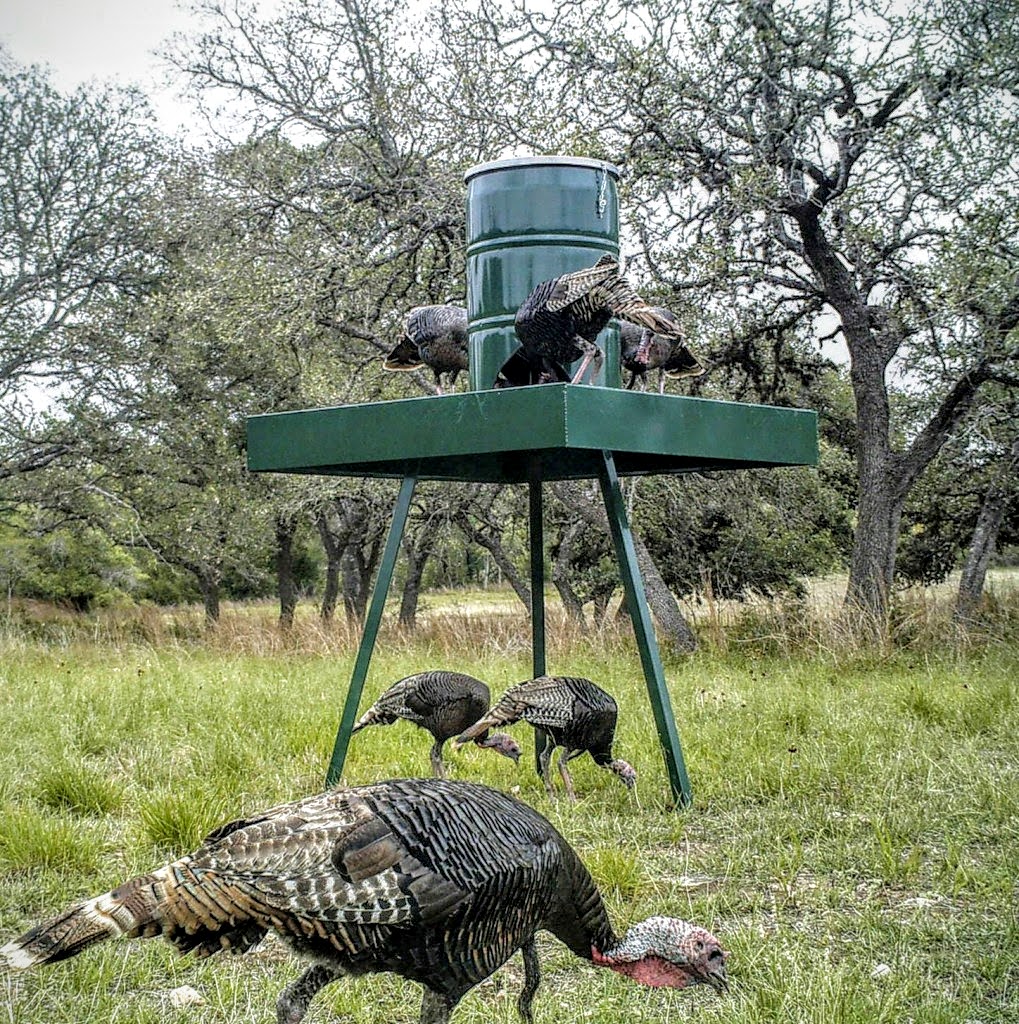 As landscapes become more fragmented, so can wildlife food resources. There’s no better food source than quality habitat, but supplements can serve a role in your management. Providing feeders for wild turkey and other wild birds can attract, retain, and possibly improve their populations on your property. Supplementing wildlife with high-quality food sources can improve nutrition during stressful/dry times of the year or pivotal times in their life cycle. Common motivations for this are feeding protein supplements to deer during antler growth or providing food to birds during migration and breeding. Concentrated supplemental food sources like feeders or food plots are also great ways to attract wildlife for observation and population surveys.
As landscapes become more fragmented, so can wildlife food resources. There’s no better food source than quality habitat, but supplements can serve a role in your management. Providing feeders for wild turkey and other wild birds can attract, retain, and possibly improve their populations on your property. Supplementing wildlife with high-quality food sources can improve nutrition during stressful/dry times of the year or pivotal times in their life cycle. Common motivations for this are feeding protein supplements to deer during antler growth or providing food to birds during migration and breeding. Concentrated supplemental food sources like feeders or food plots are also great ways to attract wildlife for observation and population surveys.
How does supplemental food fit into my Wildlife Management Plan?
Texas wildlife tax valuation law allows landowners to qualify in the supplemental food category by providing high-quality, free-choice food resources to targeted wildlife species. The recommended rate of one feeder per 320 acres qualifies for credit within the supplemental food category, though a higher density of strategically placed feeders will offer added benefits for some species. Feeders often improve opportunities for wildlife observations enjoyed by landowners and can be utilized with survey techniques to assist in census efforts, another qualifying Wildlife Management activity.
What is an appropriate food source?
The food source should fit your target species. Protein or mineral supplements for deer, mixed grains for Wild Turkey, seed mixes for songbirds, and nectar for hummingbirds are all appropriate. Food plots should provide both warm-season (late spring-early fall) plants and cool-season (late fall-early spring) plants for your target species. For deer, that often means legumes in the summer and oats or other cereal grains in the winter, though there are a lot of options available for deer food plots. When manipulating natural vegetation, the goal is to stimulate plants that are already in the soil (usually under-appreciated forbs/wildflowers, aka weeds).
What does NOT qualify as a supplemental food source under Wildlife Management?
- Placing a feeder or providing supplements outside the area designated for Wildlife Management valuation on your property – for example, if you were to place a feeder inside the boundary of your residential area, this would not count as a Wildlife Management activity.
- Using a spin-cast feeder. Timed feeders are great for wildlife watching and hunting but don’t serve wildlife as well since you are controlling how much they can eat.
- Using only corn as a food source. Again – corn is great for hunting and wildlife watching, but it is a bait, not a qualifying food supplement.
Whether you are in Wildlife Management and providing supplemental food as a qualifying activity, or are just looking to improve the wildlife on your property, providing food during hot and dry periods is an important aspect of good land management. Plateau has a range of feeders, from quail and small wildlife stations to platform feeders. Contact us if you’re interested in learning more about your qualifying Wildlife Management activities or to learn more about our feeder options – (512) 894-3479 or [email protected].
5 Tips to Attract Backyard Birds
By Danielle Belleny, Plateau Staff Biologist II
Attracting birds to your yard can be a fun and exciting activity for all ages to participate in. With fall and winter bird migrations just around the corner, providing a few essential items for birds can turn your yard into a choice rest stop. You and your family will have many opportunities to watch and listen to the feathered visitors while they feed, drink, and rest their wings before heading further south.
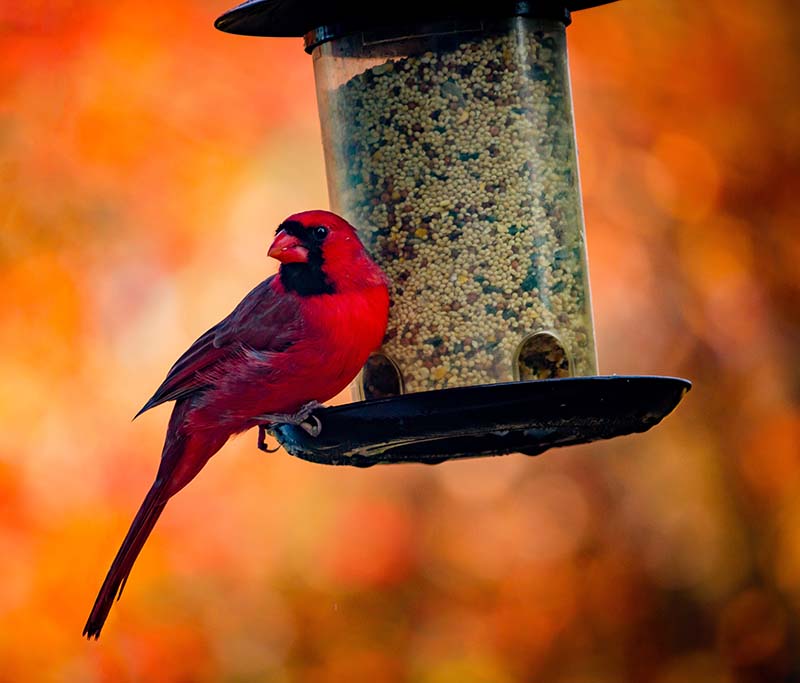 Here are 5 tips to attract some common fall & winter visitors:
Here are 5 tips to attract some common fall & winter visitors:
- Provide feeders – Providing a regular source of food is the first step to attracting birds to your yard. Bird feeders come in a variety of shapes and features. Selecting the right one for your home is a matter of personal choice. You can even make your own bird feeders using recycled materials from home. Go a step further and experiment with seed mixes to see if food type changes the species that visit. Feeders can bring unexpected species together!
- Provide water – On both hot and cold days, water is needed for birds to survive. Due to the lack of rain in the winter, water sources can be difficult to come by. Provide birds fresh water in a shallow dish. Include a log or large stone in the dish so that bathing birds can climb out of the water dish easily. On days where the temperature is near freezing, it is important to make sure the water doesn’t freeze.
- Provide shelter – After making such long migratory flights, exhausted birds are in search of a safe place to land. Provide sources of shelter like bushes, patches of un-mowed grass, piles of brush, or trees to protect birds from harsh weather and predators. These sources of shelter can also provide seeds, berries, and insects for the birds to eat.
- Regularly clean feeders and water – Outdoor bird feeders with dry seed should be cleaned weekly with 9 parts water to 1 part bleach. Feeders should be cleaned more often if there is any moisture from rain, ice, or snow. To keep your water dishes and birdbaths fresh, just rinse and scrub it with nine parts water, one part vinegar. Skip the synthetic soaps and cleansers; they can strip the essential oils off of bird feathers. Concentrated areas that have frequent visitors could potentially accumulate harmful bacteria or viruses that negatively impact wildlife. Cleaning feeders regularly helps prevent the spread of disease. Wash your hands after handling bird supplies.
- Keep track of visitors – Stay vigilant and set aside a regular time that you and your family can observe the birds that stop by. Keep a log of the species observed at your feeder and the dates you encountered them. If you have trouble identifying a bird, try taking a photo and emailing it to our biologists to assist. Additionally, mobile apps like Merlin Bird ID are able to identify birds from the photos in your camera roll. Merlin Bird ID can also identify birds singing around you and show real-time suggestions for who’s singing. Other apps like Audubon Bird Guide App have large libraries of bird sounds and images to further help you identify birds.
Facebook Challenge: Take a photo of the visitors at your backyard feeder, upload it to your Facebook page, and tag Plateau Land and Wildlife Management. Your photo will then be entered into a random drawing for prizes from Plateau (including a rain gauge, coffee mug, no-trespassing gate sign, and more)!
Here are 4 species Texans all over can expect to see in their yards this fall and winter:
Cedar Waxwing – The Cedar Waxwing is named for the red, wax-like droplets on the tips of adult bird flight feathers. Additionally, adults have sharp black face masks edged with white, black chin-patches, and pale yellow belly feathers. Cedar Waxings love sugary fruits, like Ashe Juniper berries, which dominate the diet of this bird. In fall and winter, these birds gather by the hundreds to eat berries, filling the air with their high, thin, whistles. Cedar Waxwings can eat naturally fermented berries still attached to Ashe Juniper. In fact, they sometimes overindulge on fermented berries, causing unusual and laughable bird behavior.
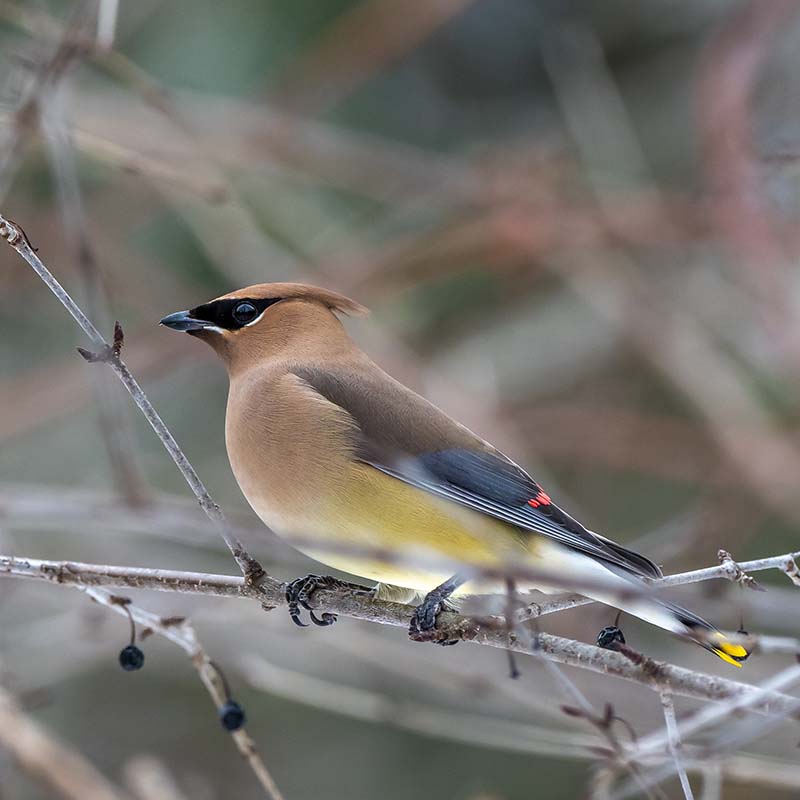
Cedar Waxwing
Pine Siskin – In the spring and summer, Pine Siskins breed as far north as central Alaska and northern Canada. In the winter, they are visitors at feeders across Texas. However, Pine Siskins are an irruptive species, meaning their numbers in a given locality are unpredictable from one year to the next due to the annual variation in the distribution and abundance of seeds that make up the bulk of their diet. Pine Siskins flock to thistle and other small seeds such as millet or hulled sunflower seeds. If your yard has plants or weeds with hardy seed heads, such as dandelion, Pine Siskins may feed there as well. Large migratory flocks can be observed moving during the day moving between food sources. Be on the watch for an exceptionally streaky, small-billed bird at your feeder. Also, listen for their distinctive call which sounds like slowly tearing a sheet of paper in two.
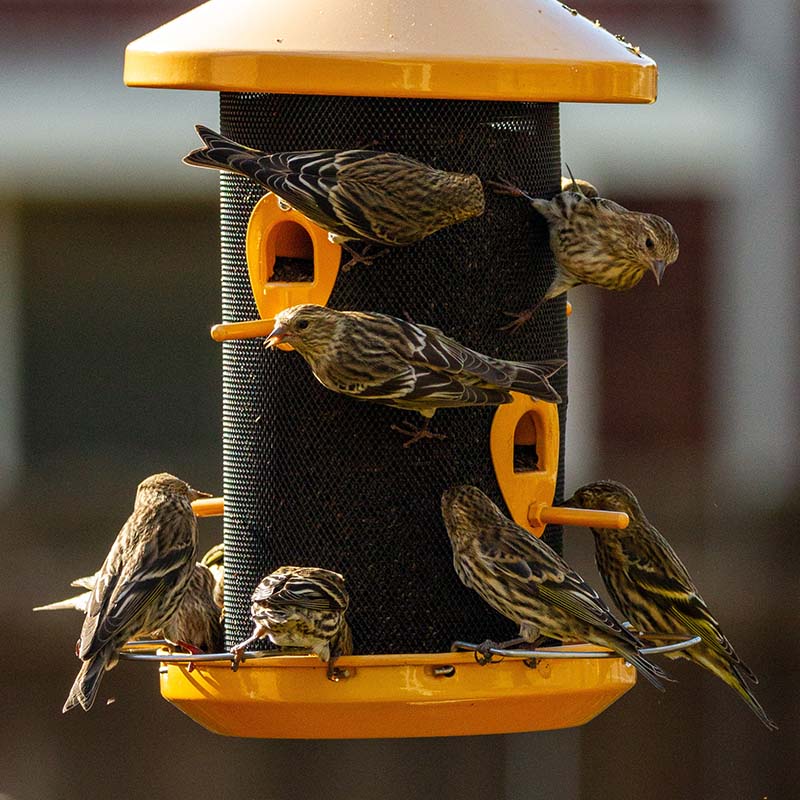
Pine Siskins
Northern Cardinal – Among the most abundant species on the continent, the Northern Cardinal is a brightly colored bird sure to grab anyone’s attention. Adult male cardinals have the characteristic ruby–red feathers and black-masked faces. The feather color of cardinals, and most other birds with reds, oranges, and yellow feathers, derives from the keratin pigments in their food sources. Male cardinals that eat high–quality red-colored berries become even more vibrant. Female cardinals and juvenile cardinals have an overall greyish-tan color with flashes of red on the margins of their wings and tails. Both sexes have the prominent crest atop their heads.
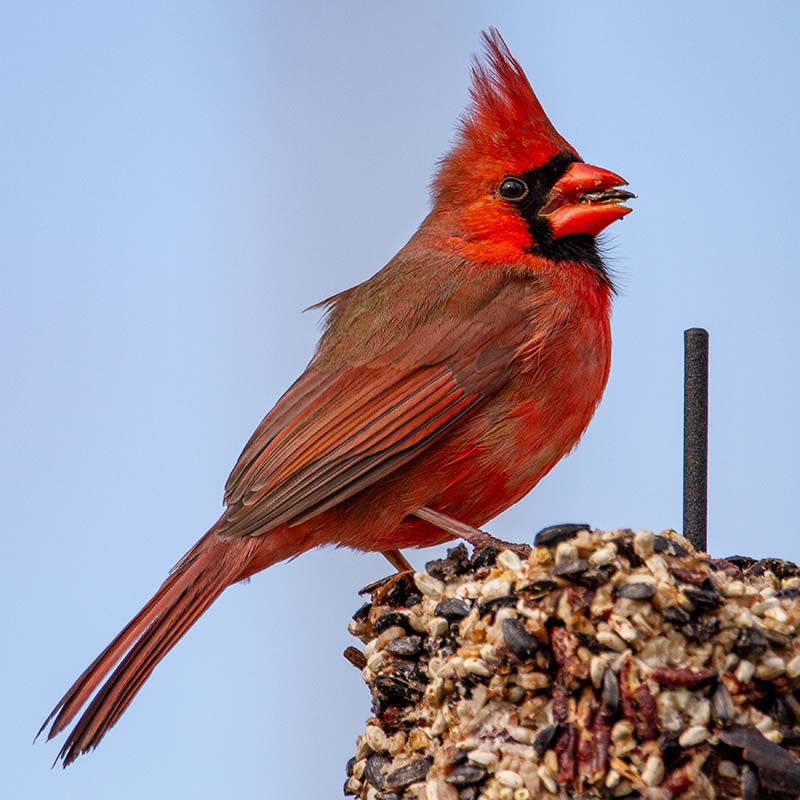
Northern Cardinal
Carolina Wren – The Carolina Wrens are shy, year-round residents that frequent homes and gardens during the day. They energetically hop through bushes, climb along tree trunks, and flip over fallen leaves in search of insects and spiders, the bulk of the wren’s diet. Wrens have a loud and varied repertoire, making them more likely to be heard before they are sighted. The entire song usually lasts less than 2 seconds and the notes are usually described as three-parted, as in a repeated teakettle or germany. Males and females have nearly identical plumage and usually mate for life.
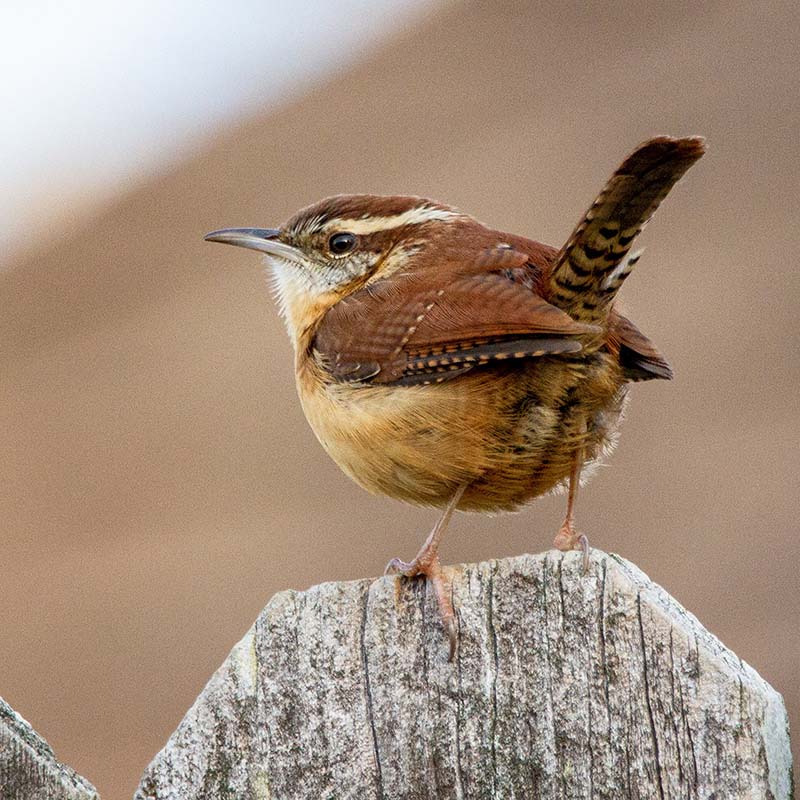
Carolina Wren
If you have questions, or need assistance identifying a particular bird species, feel free to contact us at (512) 894-3479 or [email protected].
Service Spotlight: Fall Webinars

You’re invited to our FREE Wildlife Management webinar series this fall!
Whether you’re already a Plateau customer or someone that wants to learn more about Wildlife Management, everyone is invited to join us for our FREE 2021 Wildlife Management Fall Webinar Series. Connect with experts and other Texas landowners in Wildlife Management and learn all about:
- Wildlife Management Exemption
- Wildlife Management 101
- Qualifying Wildlife Activities
- Property Taxes
- Wildlife Management Plans
- Annual Reports
- County Requirments
- Texas Regional Topics
- Open Questions & Answers
**Plus, join us for an Early Bird Special on select dates and hear from wildlife biologists and Braun & Gresham attorneys about specific issues and topics related to land ownership.**
Topics Include:
- Using Game Camera Surveys
- Common Questions About Fencing
- Fall Pollinator Plants
- Birding in the Fall
- Buying Land & Property Tax
- Brush Management in the Fall
- Horses & Wildlife Management
Register Early!
Webinars will be hosted on Tuesdays and Thursdays starting September 21st through November 9th. Visit plateauwildlife.com/webinars to register for the date and topic you choose. Register for as many as you’d like. If you miss one, no problem, just sign up for the next webinar!
Questions? Give us a call at (512) 894-3479 or email [email protected]
iNaturalist Review: What is it, and how do I use it?
By Mark Gray, Plateau Senior Wildlife Biologist and Registered Property Tax Consultant
One of the most rewarding components of working at Plateau is that I am continuously increasing my knowledge of the natural world around me. Whether I’m doing a nature walk with a leading botanist or watching a webinar on invasive plants during my lunch, I learn something daily. Shortly after Plateau’s busy season in April, I was introduced to an extremely exciting tool, the iNaturalist app. Nick Fisher, Plateau Region Manager, brought in a turtle and asked if I knew what it was. Unfortunately, or fortunately, in this case, I didn’t. Someone else suggested we could use the iNaturalist app to help with the identification. Within seconds, and in my mind with wizardry, the app had provided the correct identification of the turtle. Talk about snowballing, I downloaded it and went on a mission to trick it. Observation after observation the iNaturalist app correctly identified grasses, wildflowers, birds, and even mushrooms. It is not perfect, but this is one of the greatest tools I have used.
The iNaturalist app, and even deeper with the web interface, has numerous features that not only benefit the individual using it, but also the community (Roughly 1.2 million users). First of all, it aids in the identification of your observation with either an accurate match or provides an avenue for others to help in the identification by offering suggestions to the correct identity. iNaturalist is a citizen science project that allows naturalists and nature enthusiasts a means of sharing and exploring data. Every bit of information can potentially be used, providing a much-improved data bank. Next, it allows you to track your observations. Finally, and most importantly, it is an exceptional educational tool. I now spend several hours a week checking lights at night for moths and have a growing knowledge of moth identification. I have always believed educating yourself about the natural world around you aids in the desire to protect and preserve it. Below is a short tutorial on how to use the app. Please let me know if you have any questions. My recommendation starts with trees, shrubs, wildflowers, and bugs. Be ready to be amazed and addicted.
Field Notes: Pictures & Highlights of Properties in Wildlife Management
Ever wonder how Wildlife Management is benefiting landowners’ property and the wildlife that lives on it? Here are some photos and highlights, from Plateau’s field staff and game cameras, of successes and small victories our landowner customers are seeing on their property.
Monarch Caterpillars on Milkweed
Antelope Horn milkweed plants (Asclepias asperula) are host plants for monarch and queen butterflies. Monarch butterflies use Central Texas as their first stop on their long migration north. Milkweeds are so very important because Monarch Butterfly caterpillars can only eat milkweeds. Unfortunately, due to development and roadside mowing, milkweed is becoming more difficult to find in the Texas Hill Country. Consider planting milkweeds in your garden or on your property this fall. The buds and the flowers are quite beautiful and are such a benefit to Monarchs. Here is a fun fact for all Hill Country landowners – deer leave it alone because it tastes bad! At Plateau, we strive to teach our friends that if we all make small changes to our habits and our way of thinking, we will be better stewards for this beautiful state. Change the way you look at milkweeds even though weed is part of their name. They are so important to our native habitat!
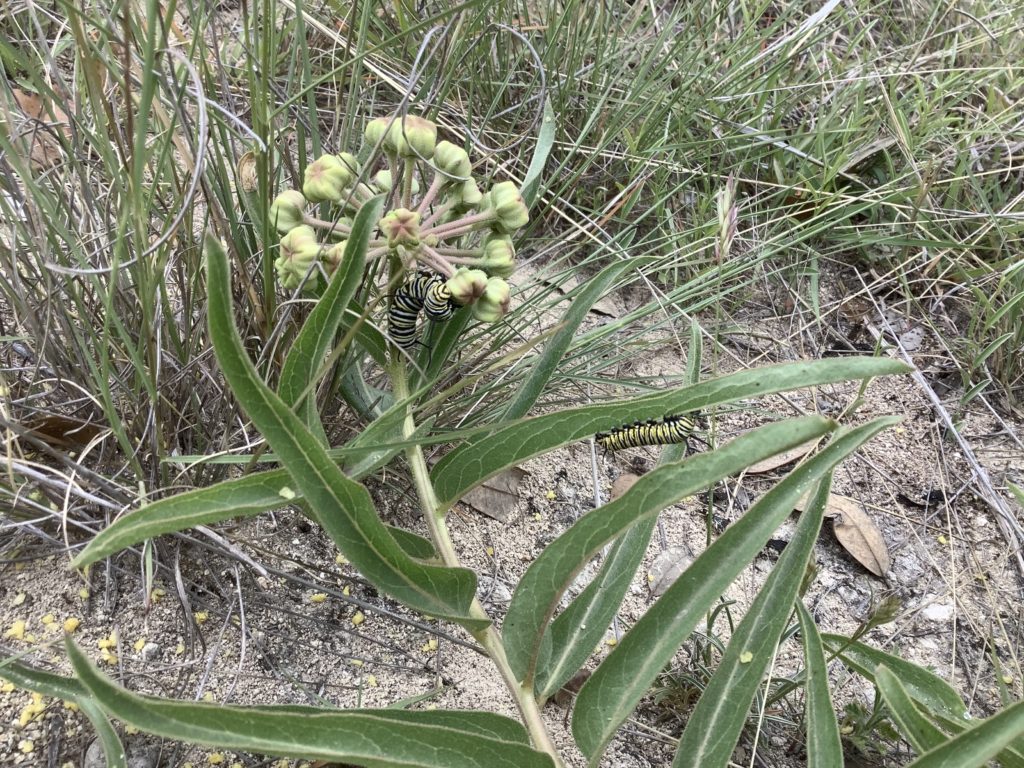
Monarch caterpillars on Milkweed, taken in Williamson County. Photo courtesy of Plateau Staff Biologist, Joshua Wright.
Nestlings in Plateau Nest Boxes
This fall is a great time to be placing new nest boxes, or cleaning out old nest boxes of past nesting materials in preparation for next spring. It is always a pleasant surprise, for our landowners and biologists alike, to find nestlings utilizing Plateau’s Nest Boxes during spring. If you happen upon some nestlings when performing nest box checks, no harm done! Simply snap a picture to provide to your County Appraisal District in your annual report, and be proud that you are doing your small part for nature.
New to Wildlife Management and need help installing your nest boxes? We provide professional nest box installation and capture each location with a GPS waypoint for future mapping. We also take photos to document this wildlife activity and provide a completed field management log sheet that you can use to show County Appraisal Districts in your annual report, or during an unexpected site inspection. When purchasing your nest boxes, simply ask about this service, or give us a call at (512) 894-3479 to order yours today!
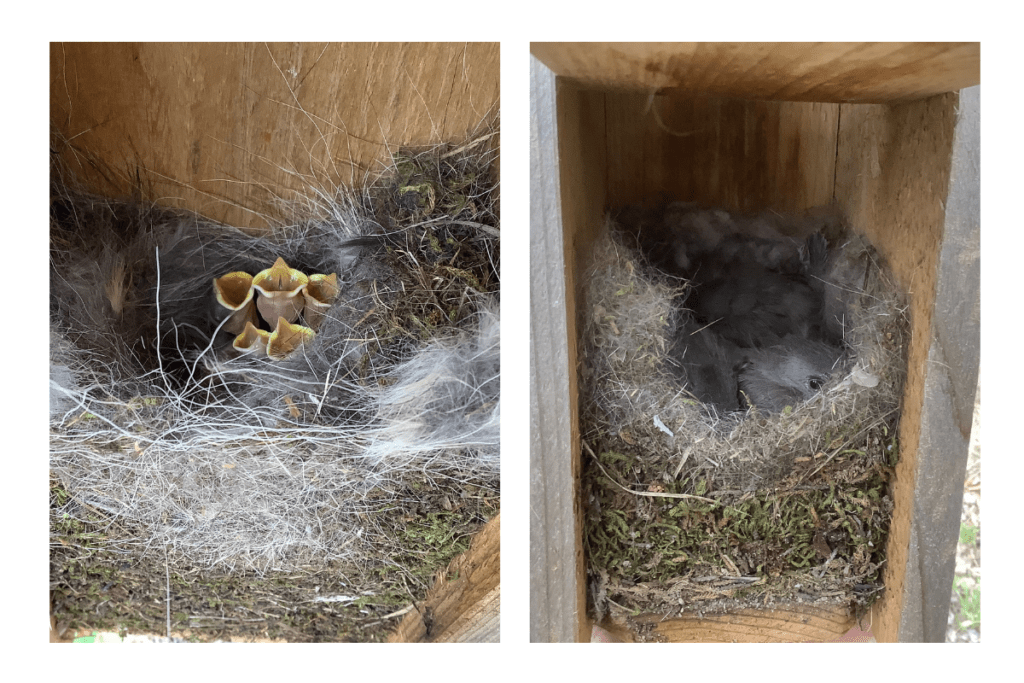
Photos of nestlings utilizing Plateau’s Nest Boxes. Courtesy of Plateau Staff Biologist, Joshua Wright.
Sleeping Fox on Game Camera
Placing game cameras on your land can give you an idea of what wildlife frequent your property. Check out this adorable photo of a sleeping gray fox that was captured on one of our landowner’s game cameras. To learn more about the proper placement of game cameras for your property in Wildlife Management, give us a call at (512) 894-3479. Or, consider joining us for our September 21st webinar for an “Early Bird Special” on Using Game Camera Surveys!
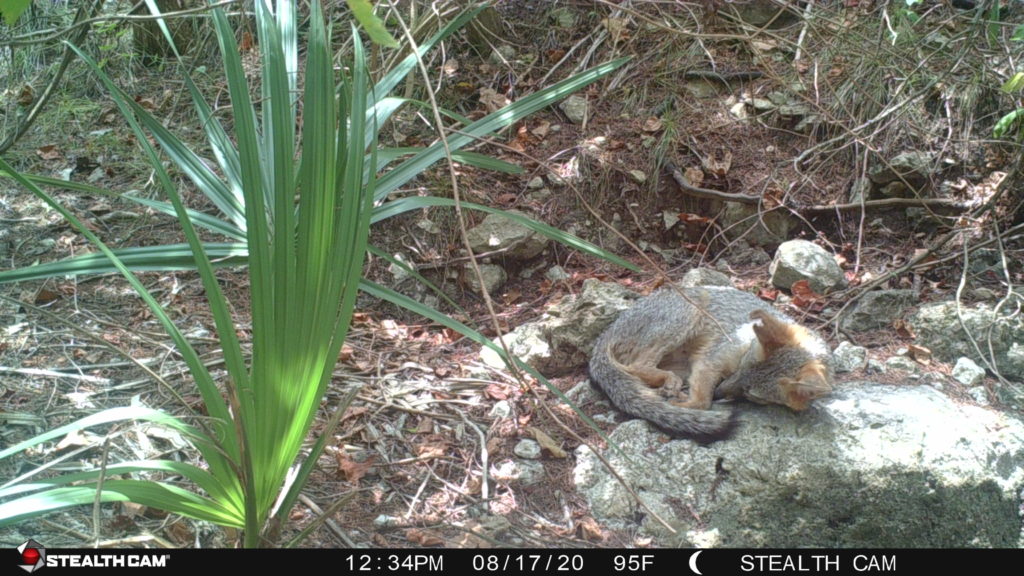
Photo of a sleeping fox captured by a game camera.
So many of you are out there doing great work. We appreciate you, and so do the native wildlife on your property and across Texas. Large or small, you are making a difference. Look for more great examples of wildlife and landowner successes and victories in upcoming Seasons Newsletters!
News for Texas Landowners
Save Our Pollinators, Save Our World
Article by Laura Muntean for Texas A&M AgriLife
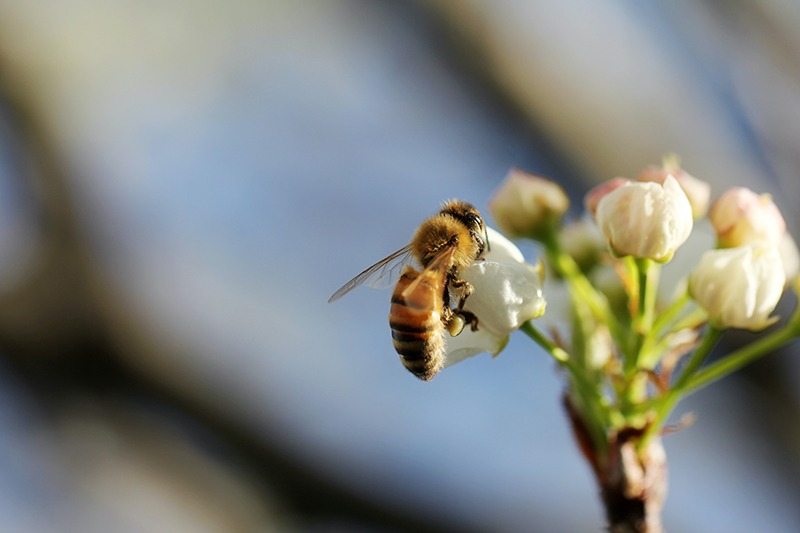
Pollinators serve a great purpose in the agriculture world. Without them, humans and animals would have little to no food at all.
Texas A&M AgriLife researcher Juliana Rangel, Ph.D., director of the Texas A&M Honey Bee Lab and associate professor of apiculture in the Texas A&M College of Agriculture and Life Sciences Department of Entomology, explains the incredible impact that such typically small animals and insects play in the role of our food supply.
To put it in perspective, Rangel explained how about 75% of plants rely on either animal or insect pollination. Pollination, the transfer of pollen from the male germplasm of a flower to the stigma of another flower, often creates a seed that will later turn into a crop like a fruit, vegetable or nut. The other 25% of pollination typically comes from natural elements like wind and water…
Lights Out Texas
News Release by BirdCast
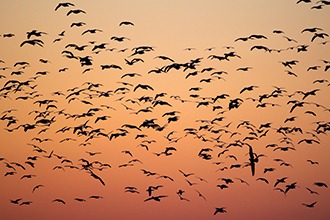
Texas is globally important for birds. Approximately 1 of every 3 birds migrating through the U.S. in spring, and 1 of every 4 bird migrating through the U.S. in the fall, or nearly two billion birds, pass through Texas. Protecting birds in Texas promotes conservation of bird populations across the Americas.
Thanks to a partnership effort, the Lights Out Texas initiative and pilot project made a lot of exciting news during the Fall of 2020. This initiative was led by the Cornell Lab of Ornithology, Texas Conservation Alliance, Dallas Zoo, the Perot Museum of Nature and Science, Houston Audubon, Texan by Nature, and many others. Mayor Johnson issued a proclamation declaring “Lights Out Nights” in Dallas last Fall.
For Spring 2021, these groups unified efforts across Texas for even bigger impact…
How Texas Wildlife Crossings are Saving Lives and Money
Article by Patricia Sharpe for Texas Monthly
 Its eyes two ghostly white spheres, a slim deer stands in the middle of the nighttime photo, serenely munching a branch. In the next picture, a coyote inspects the camera, its nose huge like that of a pet dog sniffing an iPhone. Then come fuzzy cottontail rabbits and a scraggly possum. Taken in April by trailside cameras, the black and white pictures are—in their low-res way—historic. They are the first official recordings of animals using the largest wildlife crossing in the United States: the new Robert L. B. Tobin Land Bridge on San Antonio’s North Side. Measuring some 150 feet in both length and width, the structure arches gently over the traffic on the six-lane Wurzbach Parkway below. The final portion of the bridge opened to considerable media acclaim in April, with the express purpose of joining the two sides of Phil Hardberger Park and providing a safe passage for both the people and the countless wild animals that pass through its 330 wooded acres…
Its eyes two ghostly white spheres, a slim deer stands in the middle of the nighttime photo, serenely munching a branch. In the next picture, a coyote inspects the camera, its nose huge like that of a pet dog sniffing an iPhone. Then come fuzzy cottontail rabbits and a scraggly possum. Taken in April by trailside cameras, the black and white pictures are—in their low-res way—historic. They are the first official recordings of animals using the largest wildlife crossing in the United States: the new Robert L. B. Tobin Land Bridge on San Antonio’s North Side. Measuring some 150 feet in both length and width, the structure arches gently over the traffic on the six-lane Wurzbach Parkway below. The final portion of the bridge opened to considerable media acclaim in April, with the express purpose of joining the two sides of Phil Hardberger Park and providing a safe passage for both the people and the countless wild animals that pass through its 330 wooded acres…
Attwater’s Prairie Chicken Numbers ‘Booming’ at Nearly 30-Year High
Article by Matt Wyatt for Houston Chronicle
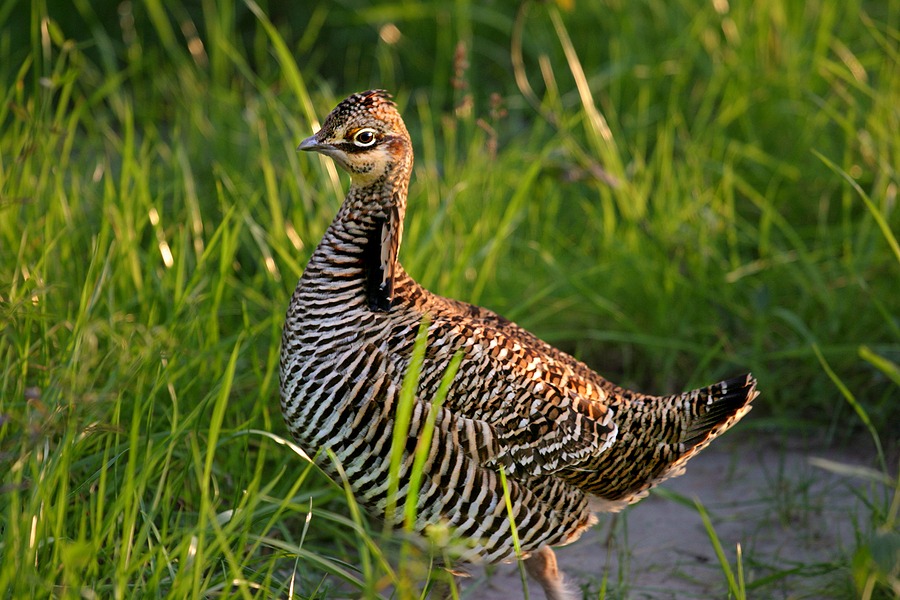 The Attwater’s prairie chicken, a living symbol of Texas and one of the most endangered species in the world, has achieved a population level not seen in 28 years.
The Attwater’s prairie chicken, a living symbol of Texas and one of the most endangered species in the world, has achieved a population level not seen in 28 years.
An annual survey by the U.S. Fish and Wildlife Service and The Nature Conservancy indicates a 2021 population of 178 birds, up from 142 last year and the highest estimate since 456 birds in 1993.
89 males were counted while “booming,” a unique breeding ritual that gathers male Attwater’s prairie chickens at a lek to attract mates by shuffling their feet and deflating the yellow air sacs on their necks, making a booming sound. The count is doubled for a population estimate because Attwater’s prairie chickens typically exist at a one-to-one gender ratio in the wild…






Sorry, the comment form is closed at this time.